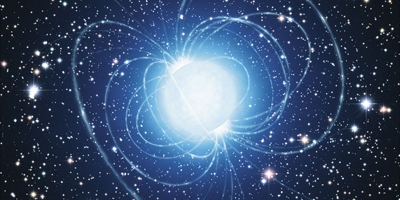May 2, 2014 report
Researchers find possible evidence of toroidal magnetic field surrounding magnetar

(Phys.org) —Space researchers in Japan working at the Suzaku observatory have found possible evidence of the existence of a toroidal magnetic field surrounding the magnetar 4U 0142+61. In their paper published in the journal Physical Review Letters, the research team describe their observation of inconsistent pulses coming from 4U 0142+61, suggesting the presence of an external magnetic field.
Magnetars are a class of neutron star—both trace their origins to a supernova. What sets them apart is the strength of their magnetic fields—magnetars, as their name implies, are very strongly magnetic, with some measured at 1011 Tesla, approximately a billion times stronger than anything found on Earth. They are also extremely dense, of course, and somewhat small—generally no more than 20 kilometers in diameter. For some time, space scientists have theorized that magnetars also have a second doughnut-shaped (torus) magnetic field surrounding their equator, perhaps even stronger than the one measured at their surface. In this new effort, the researchers appear to have found evidence for just such a magnetic field surrounding 4U 0142+61.
In studying the magnetar, the researchers were analyzing the strong x-ray emissions that come from its poles—pulsating every 8.7 seconds. But then they noticed something else, the pulse was not consistent. Sometimes the pulse came slightly early, sometimes slightly late, a far cry from pulsars which are as consistent as an atomic clock. The researchers suggest the inconsistency is due to a toroidal magnetic field over the magnetar's equator. They believe such a field, with a strength of up to 1012 Tesla would squeeze the magnetar into the shape of a football. And like a football, it could conceivably wobble as it spins, in this case with a period just a fraction of the spin period. That, the researchers suggest, would explain the inconsistent pulse.
If this new theory by the team in Japan proves to be true, then the wobbling of 4U 0142+61 should be causing gravity waves to be generated, and if that is the case, then future gravity wave detectors should be able to prove that magnetars due indeed have extremely strong gravity fields hovering over their equators.
More information: Possible Evidence for Free Precession of a Strongly Magnetized Neutron Star in the Magnetar 4U 0142+61, Phys. Rev. Lett. 112, 171102 – Published 30 April 2014
ABSTRACT
Magnetars are a special type of neutron stars, considered to have extreme dipole magnetic fields reaching ∼1011 T. The magnetar 4U 0142+61, one of the prototypes of this class, was studied in broadband x rays (0.5–70 keV) with the Suzaku observatory. In hard x rays (15–40 keV), its 8.69 sec pulsations suffered slow phase modulations by ±0.7 sec, with a period of ∼15 h. When this effect is interpreted as free precession of the neutron star, the object is inferred to deviate from spherical symmetry by ∼1.6×10−4 in its moments of inertia. This deformation, when ascribed to magnetic pressure, suggests a strong toroidal magnetic field, ∼1012 T, residing inside the object. This provides one of the first observational approaches towards toroidal magnetic fields of magnetars.
Journal information: Physical Review Letters
© 2014 Phys.org




















